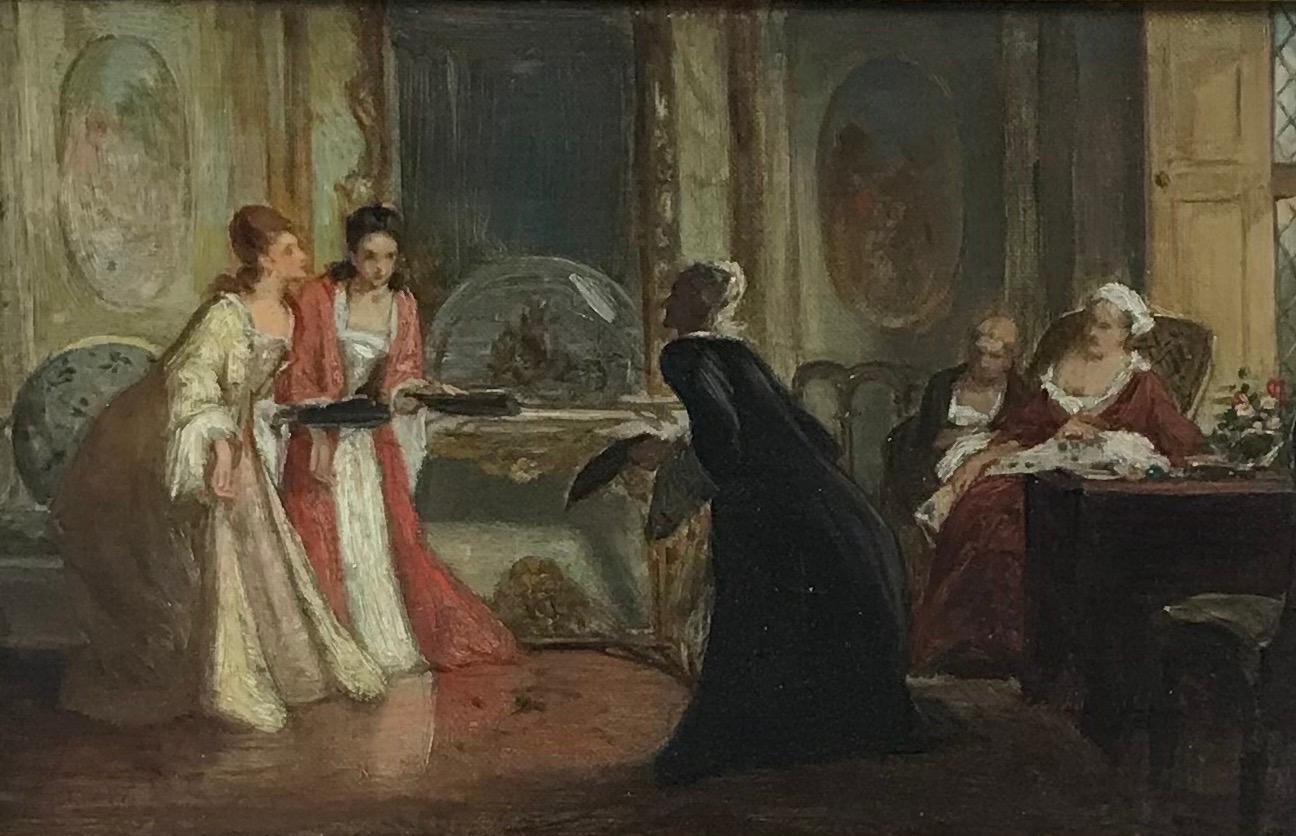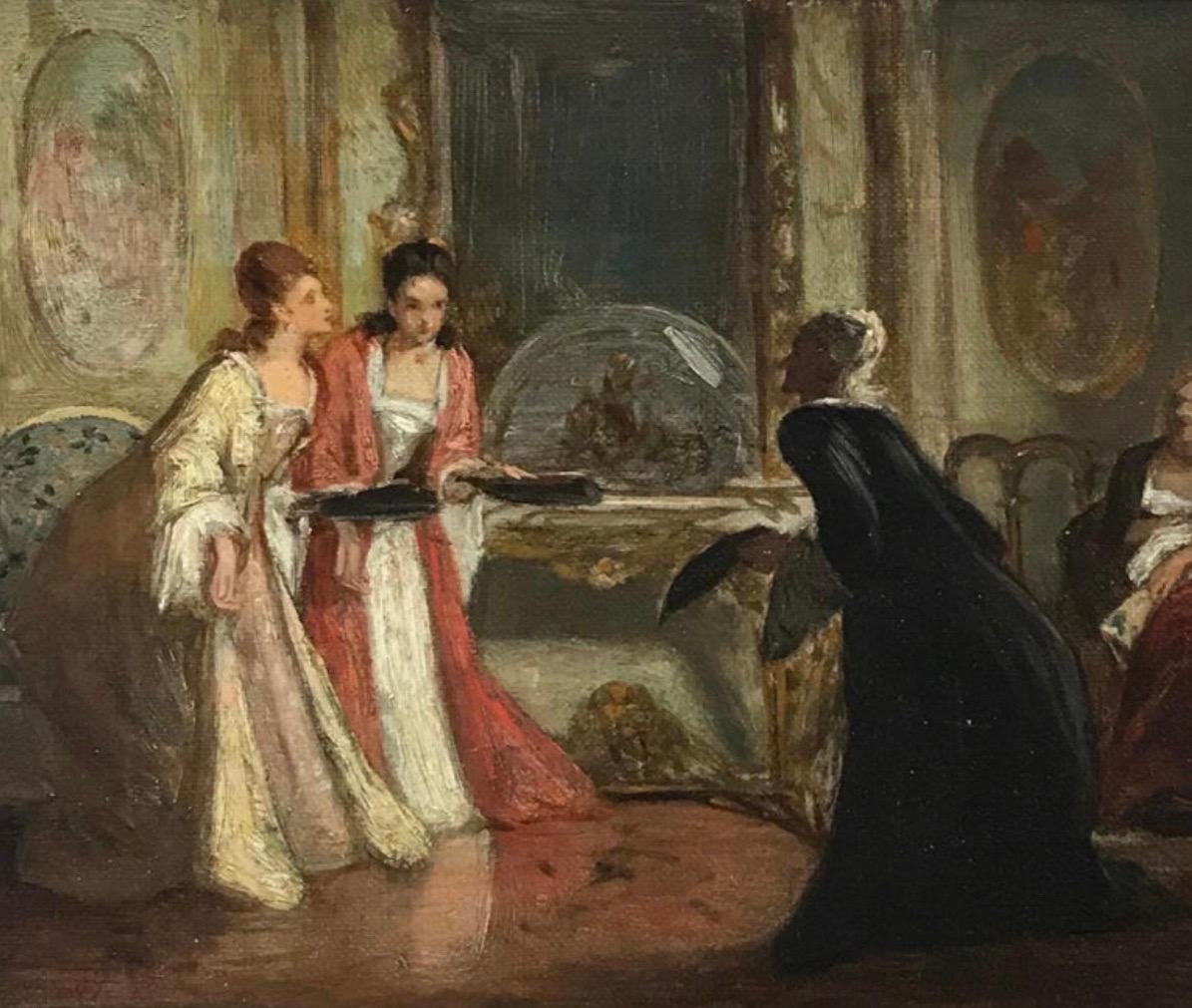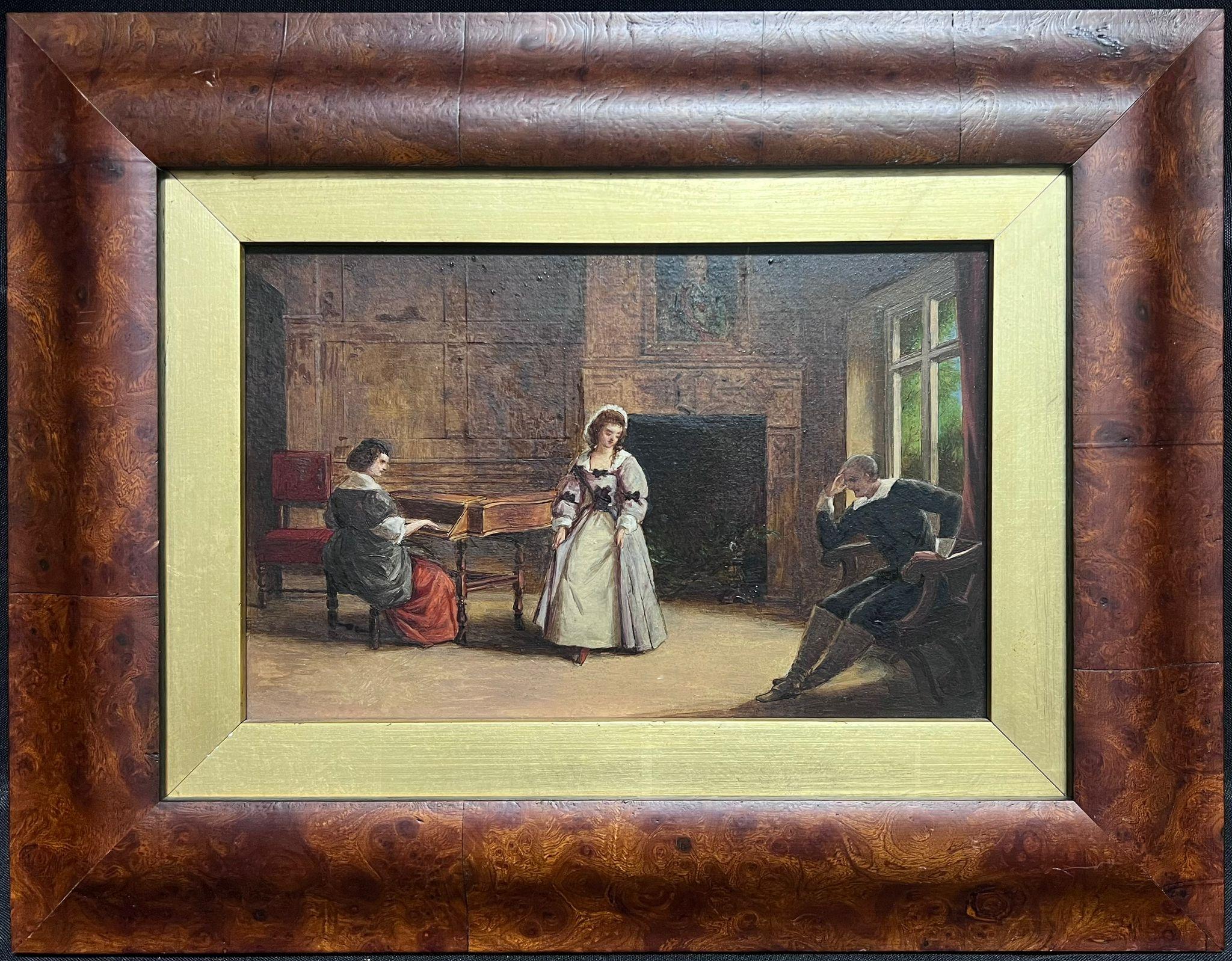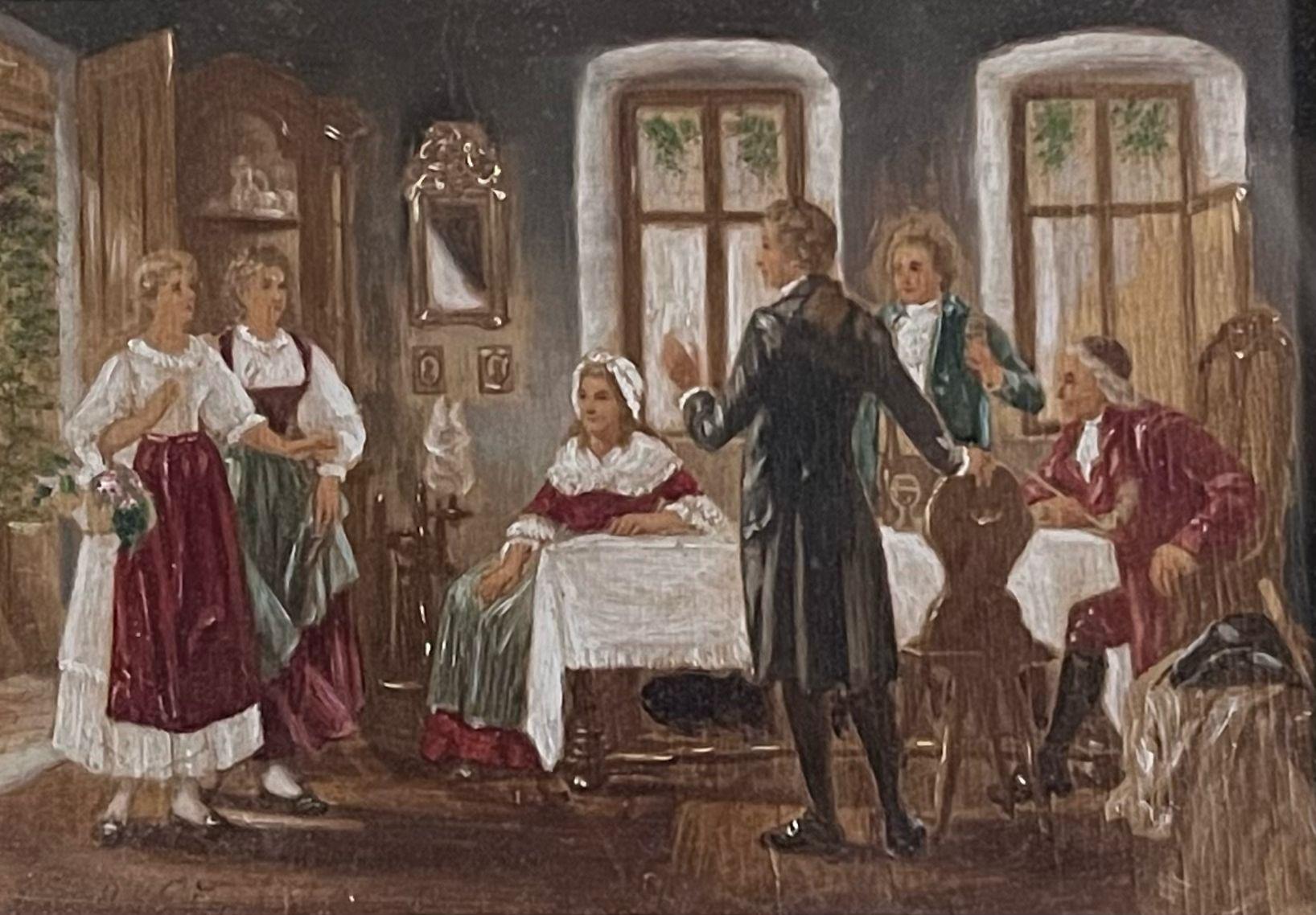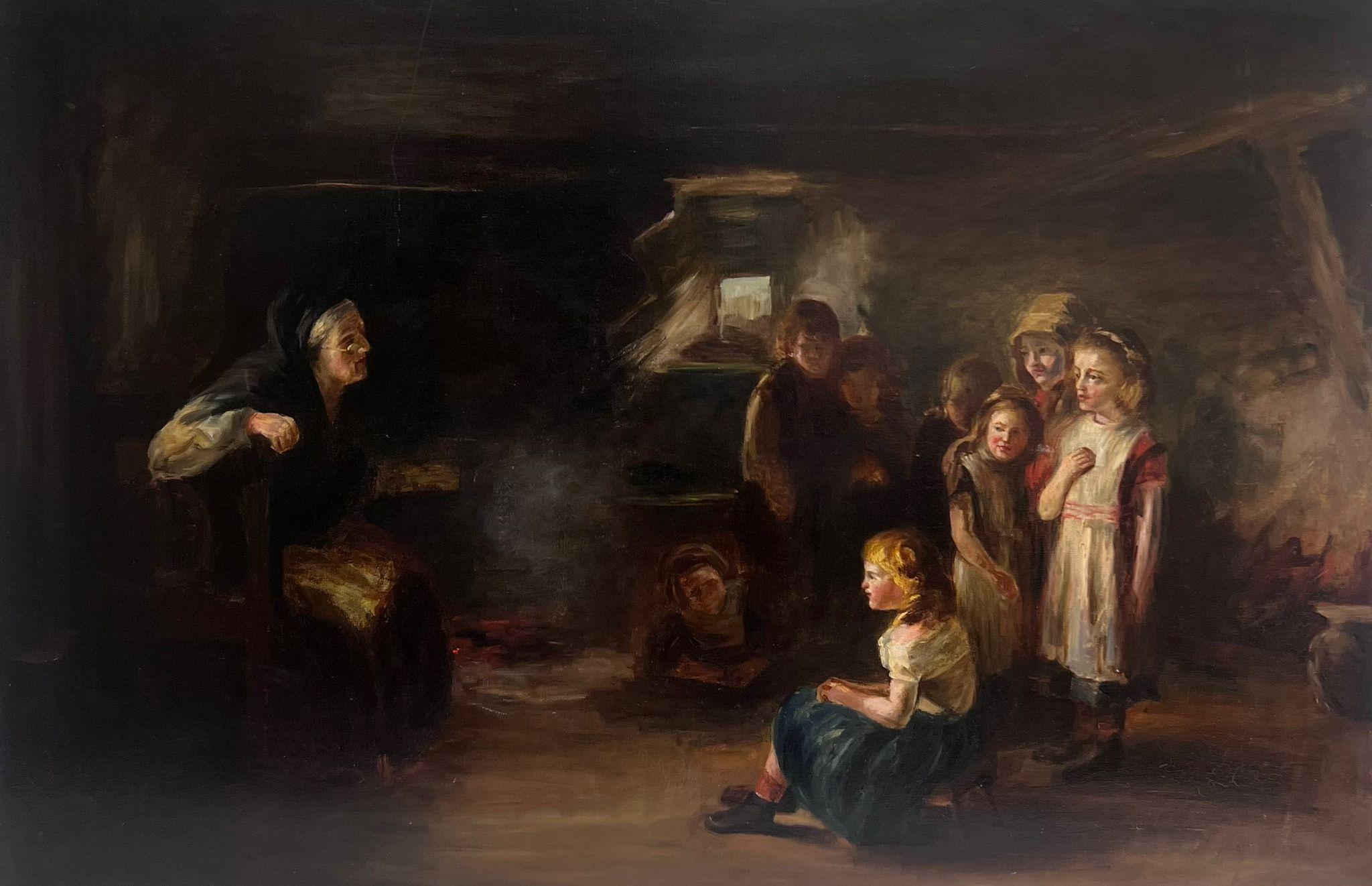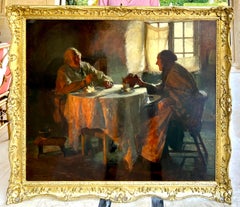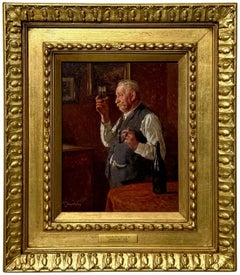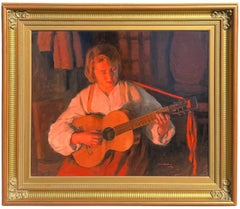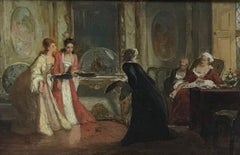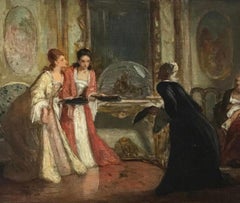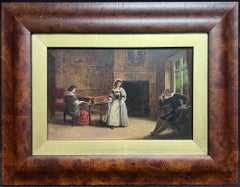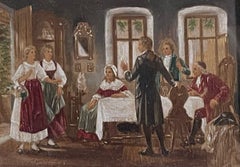Items Similar to A Peaceful Moment
Video Loading
Want more images or videos?
Request additional images or videos from the seller
1 of 10
Eduard von GrütznerA Peaceful Moment1882
1882
$9,800
£7,430.87
€8,582.57
CA$13,750
A$15,317.19
CHF 8,079.58
MX$185,725.68
NOK 102,783.87
SEK 95,749.68
DKK 64,089.35
About the Item
Oil on board, signed and dated in the lower right corner. Presented in a period gilt frame this painting depicts a content monk enjoying a peacful moment presumably in the cellar. Measures 29" x 25" including the frame.
Eduard Theodor Ritter von Grützner (May 26, 1846 – April 2, 1925) was a German painter and professor of art. He was especially noted for his genre paintings of monks. He also repeatedly portrayed Falstaff.
Grützner was born in 1846 into a noble family in Groß-Karlowitz near Neisse, Upper Silesia, Prussia (now Poland). His father was a prominent member of the church, and the local pastor often visited his parents' home. He recognized Eduard's talent and inclination for painting early on. The administrator of a ducal country house in the neighborhood got him paper, and eventually the pastor gained him entrance to the Gymnasium (a university preparatory school) of Neisse.
In 1864, the pastor brought Grützner to the private school of Hermann Dyck in Munich for art education, though his tenure at the Kunstgewerbeschule under Dyck was of short duration. In the first semester he transferred to the Classical Art class of Johann Georg Hiltensperger and Alexander Ströhuber, where the students learned about the aesthetic ideals of antiquity.
In 1865, Grützner joined the painting class of Hermann Anschütz at the Munich Academy. Meanwhile, he also sought advice and inspiration from Carl Theodor von Piloty; he was taken into Piloty's class in 1867. Piloty's class included aspiring artists from Hungary, Greece, Germany, Russia, and Poland. After three years under Piloty, Grützner left the academy.
In 1870, Grützner moved into his own studio in the garden house of Schwanthalerstraße 18 in Munich. He quickly began to produce many paintings, and he became a very successful artist. It was reported by artist and writer Friedrich Pecht in the journal Die Kunst für Alle (Art for All) in 1886: "the painters Eduard Grützner and Ludwig Willroider were granted the title of 'professor' by Luitpold, Prince Regent of Bavaria". In 1880, he was awarded the Order of Merit of St. Michael (Knight's Cross) first class. He was knighted in 1916.
Grützner was an avid collector of art. Early on, he favored pieces from the German late Gothic and early Renaissance. In the last decade of his life, he turned from the late Middle Ages and collected art from the Far East. In his major compositions, however, he almost always included old pieces, mostly from his antique collection.
In 1874, Grützner married Barbara Link. Two years later, they had a daughter named Barbara. In 1884, after ten years of marriage, his first wife died. In 1888, he became engaged to Anna Grützner Wirthmann, the daughter of a Munich garrison commander, and a short time later their son Karl Eduard was born. This second marriage was less harmonious and eventually his wife, who was seventeen years younger, left him for a Viennese singer.
In his old age he sought solace in Chinese philosophy, and began to collect items from the far east and learn Japanese. Occasionally he included a Buddha figure or a Chinese vase in some of his paintings. He also painted a number of ascetic-looking cardinals, often with harsh and unsympathetic features. He died on April 2, 1925, in Munich.
Grützner was, along with Carl Spitzweg and Franz von Defregger, one of Munich's leading genre painters in the second half of the 19th century. Grützner's paintings are best known for their combination of detailed academic rendering with humorous and anecdotal subject matters.
- Creator:Eduard von Grützner (1846 - 1925, German)
- Creation Year:1882
- Dimensions:Height: 29 in (73.66 cm)Width: 25 in (63.5 cm)Depth: 2 in (5.08 cm)
- Medium:
- Movement & Style:
- Period:
- Condition:
- Gallery Location:Wiscasett, ME
- Reference Number:1stDibs: LU506316766662
About the Seller
5.0
Vetted Professional Seller
Every seller passes strict standards for authenticity and reliability
Established in 1999
1stDibs seller since 2016
109 sales on 1stDibs
Typical response time: 2 hours
- ShippingRetrieving quote...Shipping from: Wiscasett, ME
- Return Policy
Authenticity Guarantee
In the unlikely event there’s an issue with an item’s authenticity, contact us within 1 year for a full refund. DetailsMoney-Back Guarantee
If your item is not as described, is damaged in transit, or does not arrive, contact us within 7 days for a full refund. Details24-Hour Cancellation
You have a 24-hour grace period in which to reconsider your purchase, with no questions asked.Vetted Professional Sellers
Our world-class sellers must adhere to strict standards for service and quality, maintaining the integrity of our listings.Price-Match Guarantee
If you find that a seller listed the same item for a lower price elsewhere, we’ll match it.Trusted Global Delivery
Our best-in-class carrier network provides specialized shipping options worldwide, including custom delivery.More From This Seller
View AllTea Time
By Frank Bramley
Located in Wiscasett, ME
Signed and dated 92 lower left. Oil on canvas. Frank Bramley British, 1857-1915 Frank Bramley is considered one of the most important artists of the Newlyn School, the group of artists who settled in Newlyn, Cornwall during the 1880s and 1890s, drawn by the light, lifestyle and the example of Alexander Stanhope Forbes, and were at the forefront of 'British Impressionism'. He was particularly ‘in the news’ when his painting of a woman reading in a garden made the astonishing price of $590,000 at Sotheby's New York in late May 1996. As the seminal catalogue of the famous Newlyn School exhibition states, Bramley's reputation has rested for some time on Hopeless Dawn, his major RA exhibition of 1888, and which in recent years has been hung almost constantly at the Tate Gallery. Bramley was born in Lincolnshire and trained at Lincoln Art School, later at Verlat's Academy in Antwerp, from where he went to Venice in 1882-83, where our painting was executed. He first showed at the Royal Academy in London in 1884 (both paintings were Venetian scenes), and it was in the winter of 1884/5 that Bramley settled in Newlyn. He was a quiet and reserved figure, prone to bouts of melancholy. He worked on his own in a tiny studio in an old thatched cottage - the cottage consisted of two rooms, one at ground level (which was the studio) and one which was below ground which was inhabited by a woman who'd lost her arms and who managed to look after a set of tiny children as well as a small potato and turnip shop. Bramley moved to a purpose-built glass studio in 1889. He is known as the master of the so-called 'square-brush technique' which characterizes much of the best Newlyn School work and he used this until 1893, later than most of his colleagues. Bramley was friendly with the great artist Sargent and with him was elected an associate of the Royal Academy in 1894, being elected a full member in 1911. In 1891 he had married, and 4 years later they moved to the Midlands where his work became less socially orientated and more purely decorative. His last years were spent in a London flat...
Category
1890s Victorian Figurative Paintings
Materials
Oil
$58,000
An Experienced Eye
Located in Wiscasett, ME
A skilfully rendered oil painting on board by Austrian artist Adolph Reich skifully expresses the careful consideration and focus of a vintner or distiller as they study and are abou...
Category
Early 20th Century Victorian Interior Paintings
Materials
Oil, Board
Playing Guitar by the Fire
By Sam Uhrdin
Located in Wiscasett, ME
This oil on canvas is signed and dated in the lower right and measures 32.5" x 37" including the frame. The scene depicts a young lady playing her guitar by the light of the fire. Th...
Category
1950s Victorian Figurative Paintings
Materials
Oil
The Chemist
Located in Wiscasett, ME
Oil on canvas, signed in the lower right. Measures 36" x 41" including the frame. Johann Georg Meyer Von Bremen
(German 1813-1886) was a genre painter. He was the son of master baker Johann Georg Meyer. His mother was strictly religious. From 1833 he studied at the Düsseldorf Academy of Fine Arts , which was led since 1826 by Friedrich Wilhelm von Schadow, the son of the sculptor Johann Gottfried Schadow. In addition to Schadow, Karl Ferdinand Son was his teacher there. Meyer acquired the necessary craftsmanship skills to make a living from the sale of his paintings, but he was initially unable to do so. From 1841 to 1852 he maintained his own studio in Düsseldorf. On his travels to Brussels and Antwerp Meyer experienced the works of Peter Paul Rubens and Anthonis van Dyck. In 1851 he married the singer Julia Beer...
Category
19th Century Victorian Interior Paintings
Materials
Oil
Feeding the Baby
Located in Wiscasett, ME
Oil on canvas, signed upper left. Provenance: Sothebys Amsterdam, Private collection London, Private collection Palm Beach.
His working period was from about 1894 to 1973, successively in Rotterdam, Heeze (Heeze-Leende), Hilversum and Laren. He was educated at the Craft School for decorative painters and received evening lessons at the Rotterdam Academy under the direction of A. van Maasdijk.
He was a member of the Vereeniging Sint Lucas...
Category
Early 20th Century Dutch School Interior Paintings
Materials
Oil
The Painter and His Muse
By Benjamin Eugène Fichel
Located in Wiscasett, ME
Oil on panel signed in the lower right corner and presented in a period frame measuring 21" x 18.5".
Provenance:
Private Collection
Bradbury Art and Antiques, Wiscasset, ME
Benj...
Category
19th Century Baroque Figurative Paintings
Materials
Oil
You May Also Like
Elegant Ladies in Grand Drawing Room Interior, Fine 19th Century British Oil
Located in Cirencester, Gloucestershire
Artist/ School: David Wilkie Wynfield, (British 1837-1887)
Title: Elegant Ladies in a Drawing Room interior scene
Medium: oil on panel, framed
Framed: ...
Category
19th Century Victorian Figurative Paintings
Materials
Oil
Fine Victorian British Oil Painting Elegant Figures in Sumptuous Interior Room
Located in Cirencester, Gloucestershire
Artist/ School: David Wilkie Wynfield (1837-1887) British
Title: Elegant Figures in an Interior
Medium: oil painting on canvas, framed. Indistinctly Ins...
Category
19th Century Victorian Figurative Paintings
Materials
Oil
Historical Musical Home Interior Three Figures Wood Paneled Interior with Piano
By WILLIAM MAW EGLEY
Located in Cirencester, Gloucestershire
Playing for her Father
by William Maw Egley (British, 1827-1916)
inscribed verso
oil on board, framed
framed: 13 x 16 inches
board: 9 x 12.5 inches
provenance: private collection, En...
Category
19th Century Victorian Figurative Paintings
Materials
Oil
Victorian Interior with Several Figures Antique English Oil Painting
By Victorian School
Located in Cirencester, Gloucestershire
The Victorian Interior
English School, 19th century
oil on board, framed behind glass hence photo reflection glare
framed: 7 x 8.5 inches
board: 4 x 5 inches
inscribed verso
provenan...
Category
19th Century Victorian Figurative Paintings
Materials
Oil
Large Victorian English Oil Painting Cottage Interior with Many Children
Located in Cirencester, Gloucestershire
The Cottage Interior
English artist, 19th century
oil on canvas, unframed
canvas: 24 x 36 inches
provenance: private collection, UK
condition: a few small scuffs to the surface and m...
Category
19th Century Victorian Interior Paintings
Materials
Oil, Canvas
Victorian Tavern Scene Three Gentlemen in Conversation Over Drinks Oil Painting
Located in Cirencester, Gloucestershire
Discussing Ailments
by ALEXANDER AUSTEN (1859-1924)
signed with monogram
oil on canvas, framed
framed: 13.5 x 17 inches
canvas: 9 x 12 inches
Provenance: Private collection, Yorkshir...
Category
Late 19th Century Victorian Figurative Paintings
Materials
Oil, Canvas
